Basketball Defense - Al Marshall's Aggressive 2-3 Zone Defense
"The Defense Your Opponents Will Hate!"
By Dr. James Gels, From the Coach’s Clipboard Basketball Playbook"Helping coaches coach better..."
Disclosure: This page contains affiliate links, which means that Coach's Clipboard receives a small commission (at no cost to you) if you make a purchase using these links.
This is an introduction to coach Al Marshall's aggressive 2-3 zone defense, and his excellent two-DVD set, "Al Marshall's 2-3 Zone". Coach Marshall has 42 years of coaching experience and has been a very successful head boys varsity coach at Cascade HS in Cascade, Iowa. Coach Marshall has accumulated 629 career wins at the high school level and his teams have led Iowa the past six years in lowest points allowed per game. He is ranked 4th in all-time wins in the state of Iowa, and has 39 district and conference championships under his belt. Coach Marshall is noted for his great defensive teams and his 2-3 zone defense. Now in this two-DVD set, he shares the secrets of his great success.
In this article, basic defensive slides will be presented. However, the DVDs are much more detailed and also include the necessary breakdown drills, how to adjust to certain zone offenses and zone plays, how to adjust to your opponent's strengths and weaknesses, special defenses vs teams with a star player, press and transition defense that flow back into the 2-3 zone defense, and many other questions and comments. There is also a 23-page pdf document with the DVD that contains diagrams of the drills.
Why use a 2-3 zone defense?
Coach Marshall's reasons for using the 2-3 zone defense:- The 2-3 zone defense will benefit teams that are less athletic, less quick, not as tall, by keeping the ball outside and turning the opponent into an outside jump-shooting team. Athletic teams will benefit as well by being more aggressive on the outside, trapping, etc.
- Opponents tend to become impatient against the zone and often rush shots.
- Most high school players are just average passers, and have difficulty making good inside passes and accurate skip passes.
- Compared to man-to-man offenses, there are far fewer zone offenses to contend with. Man-to-man defenses may have to contend with numerous man offenses (e.g. flex, motion, triangle, read and react, Princeton, pick and roll, swing, dribble-drive, etc) as well as many set plays. Use a 2-3 zone defense and now the opponent usually has to switch to a zone offense, and there aren't nearly as many zone offenses to choose from.
- The 2-3 zone is very adaptable in countering the opponent's zone offense and plays, and their star players.
- Usually teams will commit fewer fouls when playing zone defense.
Three goals for an effective zone defense
Coach Marshall's defensive goals:- No lay-ups... clog the inside and force the opponent to shoot from outside.
- No second shots... be aggressive rebounders.
- No fouls.
Three important fundamentals in playing zone defense
- Close-out on the shooter with high hands, to pressure the shot and the pass. We are less concerned with dribble-penetration since the zone creates too much congestion inside for the dribble-drive.
- Stay in your defensive stance. This is especially important for weakside defenders. The weakside low defender should keep his "butt to the baseline" so that he can see the floor, and any potential cutters or screeners coming his way.
- Move on the flight of the ball... move quickly when the ball is in the air. Contrary to what many players think, there is no loafing or standing around in a zone. Players must "get there" and rotate quickly and must move once the ball leaves the passer's hands.
Basic 2-3 Zone Defensive Slides
Initial 2-3 Set
See Diagram A. Generally, start with two guards X1 and X2 on top, relatively close together so that the initial pass cannot go into the high post. There may be times when we want one or maybe even both defenders coming out and attacking the point guard as the ball is brought into the fore-court. But, for the most part, we start out as seen in the diagram. Notice that coach Marshall likes the two outside low defenders X3 and X4 a little higher than the middle low defender X5. This allows them to get to the wing and back on a pass to the wing.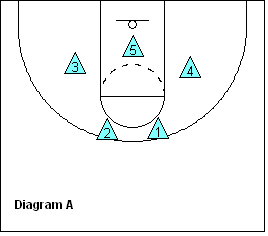
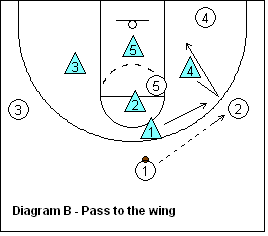
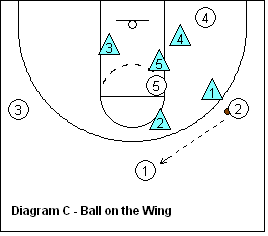
Pass to the Wing
See Diagram B. As the pass goes to the wing O2, X4 initially moves up with high hands on O2 and then retreats back once X1 gets to O2. X1 "bumps" X4 back down. Coach Marshall calls this going "on and off" for the low outside defenders X3 and X4. They initially close-out "on" the ball, and then go "off".Diagram C shows how the zone has shifted once the ball is on the wing. X4 has dropped back, X2 plays the gap between O5 and O1, and here's where knowing the opponent comes in. If O5 is the better scorer and O1 is a poor shooter, X2 sags more toward O5 - or just the opposite if O1 is a great outside shooter. Notice that X3 has moved into the paint on the weakside with his "butt to the baseline" (not turned sideways, not facing the ball) in a good defensive stance with "head on a swivel", able to see the floor so as to see a backside cutter, or a pin-screen or wing-corner skip-pass.
Pass from Wing to Point
See Diagram D. If the ball is passed back out to the point, X2 closes-out on O1. X1 drops in near the right elbow, and helps stop any dribble-drive to the right. X3 moves up some, toward the opposite elbow, and helps stop any dribble-drive to the left side.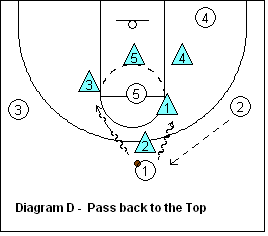
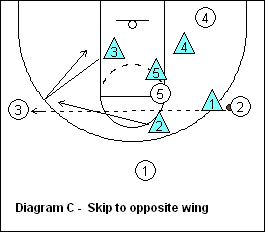
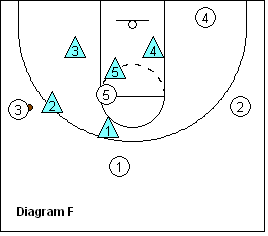
Skip-Pass from Wing to Wing
See Diagrams E and F. Instead of passing back to point, O2 might skip-pass over to O3. Here, X3 goes "on and off", initially closing out with high hands on O3, and then retreating back inside once X2 gets to O3. X1 gaps between O1 and the high post and X4 slides into the paint. All the same rules as described above under "Pass to the wing" hold true on this skip-pass... X4 with his "butt to the baseline", and X1 shading toward either O1 or O5, whoever is the better scorer.Skip-Pass from Wing to Opposite Corner ("Pin and Skip")
See Diagram G. Many zone offenses feature the weakside "pin and skip" where the low weakside defender X3 is "pinned", or back-screened, as O3 slides down to the corner for the skip-pass from O2. Now O3 will either have an open outside shot, or if X3 runs out hard, he might be able to pass inside to O4 for a lay-up.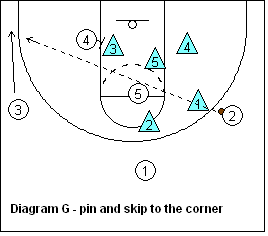
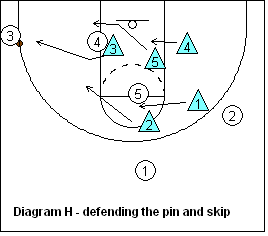
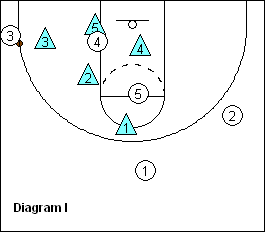
Coach Marshall defends this like this (diagrams H and I). X3, with this "butt to the baseline", should be able to see the back-screen coming, and he steps-over, goes high, over the screen, and closes-out with high hands on O3 in the corner. Meanwhile, X5 slides baseline under O4 to deny the pass inside. X4 moves into the paint and X2 drops down to about the mid-lane area. Here X2 can help deny and defend any pass inside, and can also help stop dribble-penetration by O3 into the top seam. X1 plays the gap between the high post and the point.
It's especially important in defending skip-passes to re-state the rule that all defenders must move immediately and quickly on the flight of the ball.
Pass from Wing to Short Corner
In diagram J, when O2 has the ball, often O4 will run the baseline to the ballside short corner to receive the pass there from O2 (diagram K). X4 follows the ball to the short corner to defend O4. X5 moves to the ballside low block area. On the pass to the short corner, X2 immediately drops inside to help deny the high post cut to the block and the pass to O5 (diagram L).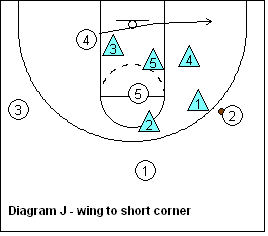
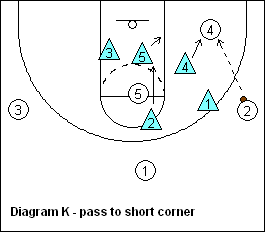
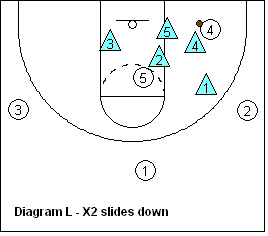
Pass into the High-Post
In diagram M, the pass goes to O5 at the high post. When this happens, both guards X1 and X2 immediately drop to the ball and "swarm" the high-post player. Note: you have to be careful doing this if either O2 or O3 is a great shooter, and one defender may have to shade toward the great shooter.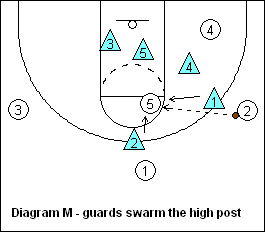
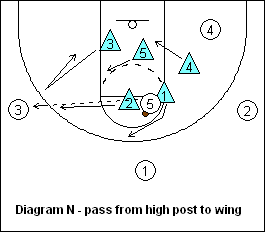
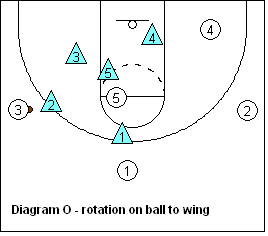
Pass from the High-Post to the Opposite Wing
Often the high-post player O5 will pass back out to the opposite wing O3 (diagrams N and O). X3 will go "on and off", initially closing-out with high hands on O3, and then retreating back inside once X2 gets to O3. Now we follow our usual rotations for a pass to the wing - X4 moves into the paint with "butt to the baseline", and X1 gaps between the high post and the point.This concludes the general ball-movement rotations.
Coach Al Marshall's two-DVD set goes into much more depth
Additional topics included are:- the necessary breakdown drills.
- how to adjust to various zone offenses, including the 1-3-1, the 4-out, and others.
- how to defend against several commonly used zone plays.
- adjustments for defending star offensive players (wing, point-guard or inside post player).
- transition and full-court, three-quarter court and half-court presses and flowing into the 2-3 zone defense.
- final questions and answers, and more comments.
- Additionally, there is a 23 page pdf document included with the DVD that diagrams all of the breakdown drills.
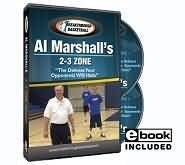
"This is an excellent set of DVDs that present in detail a 2-3 zone defense that has proven itself over many years, with great success for Coach Al Marshall and his teams." - Coach Gels
Related pages:
- 2-3 zone defense
- Principles of Zone Defense
- Breakdown Drills for Teaching the 2-3 Zone Defense
- 1-2-2 zone defense (and 3-2)
- 1-3-1 zone defense
- Amoeba Defense
- Point-Zone Defense
- Match-up zone defense